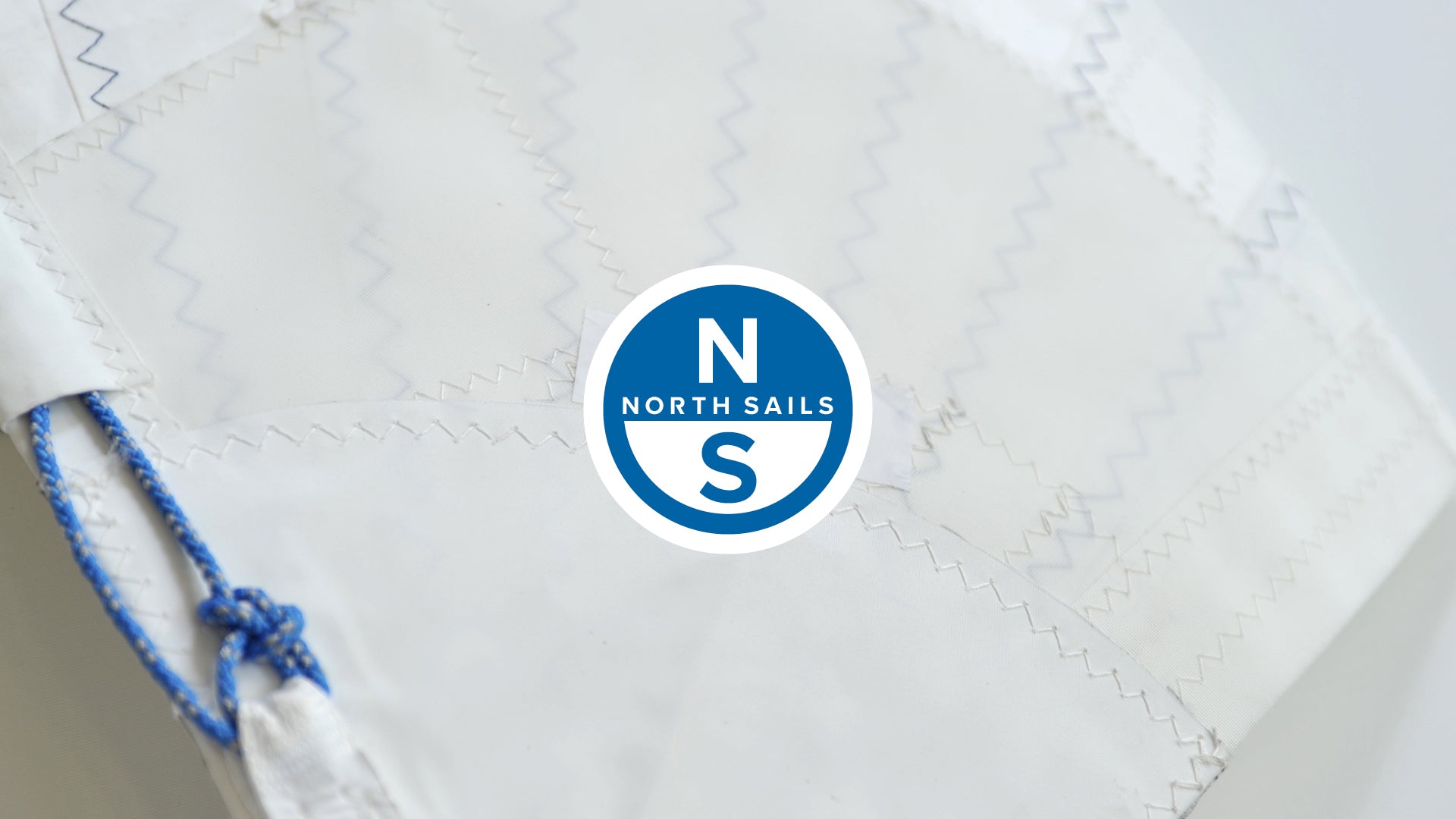ETCHELLS TUNING GUIDE
Download Australian Setup Quick Tuning Chart
Congratulation on your purchase of North One Design Etchells sails.
The following tuning guide is meant to be a good starting point in setting your Etchells rig and sails. (Download the PDF for tables and images.)
We recognize that each Etchells vary slightly from boat to boat and rig to rig. Following are 4 easy steps to set your Etchells up to establish your “BASE” positions for your mast step, rake, upper and lower tensions. You will see on the last page our Quick Tuning Chart with the base position setup for 6 to 9 knots TWS (True Wind Speed). Set your boat up to the “BASE”, and then apply our average wind range settings (yellow). From here we recommend that if necessary you customize and develop your own settings in the boxes provided (orange).
We recommend that you return your boat to “BASE” settings after each days sailing, reducing the chance of losing track of your fast rig settings. Write down the upper and lower turnbuckle calibrations to aid you with returning to BASE setting after each day.
RIG SETUP
SPREADERS
Before stepping your mast, make sure your spreaders are the same length by measuring from the shrouds perpendicular to the side of the mast. The spreaders should be fixed in place straight out, without any sweep forward or aft. Place two tape marks on the spreaders, 1’ 6 ¼” and 1’ 9 ¾” from the side of the mast. These will be used as a reference for jib sheet tension.
MAST STEP
The mast step position controls the pre- bend. Setting up with the correct amount of pre-bend is the platform to control both mainsail and jib shape. Pre-bend relates to forestay sag, being the principle control over the jib sectional shape and your steering groove. The pre-bend is governed by the relationship between the offset position on your mast partner, the alignment of the mast step and your spreader angles, a variable you cannot tune on the water. By working back from the mast partners we eliminate building variables reproducing a consistent pre- bend in your mast to marry the mainsail luff curve. Moving the mast step changes the amount the spreader engages or disengages with the uppers. By moving the mast step aft the pre-bend is increased and conversely moving the mast step forward reduces the pre-bend. This is an important step in matching your mainsail luff curve with your mast bend. This can be customized in the orange mast step box.
- Measuring from the aft edge of the mast partner, measure aft along the centerline of the deck 12’ and make a mark.
- From this mark on the aft deck measure 12’ 6 ½” to the intersection of the aft face of the mast section and mark the mast step “I” beam. This is now your “BASE” mast step position, for winds between 6 to 12 knots.
MAST RAKE
BASE Rake Setting – Disconnect the forestay above deck and swing it into the mast and mark the top of the gooseneck black bands onto the forestay. Reconnect the forestay and set the rake up at a distance of 48” measured from the black band mark down to the deck following the forestay. From BASE, in light airs we increase the forestay length by up to ¼” being 48 ¼”, subject to your boat helm balance.
MAST RAKE DEVELOPMENTS
In recent times we have seen a trend towards adjusting rake for conditions. The basic rule is longer forestay in light winds to induce weather helm/ feel, and carry a shorter forestay as the wind increases, which will reduce weather helm. If you wish to experiment with this variable we suggest trying base plus ¼” in light and base minus ¼” in fresh conditions.
IMPORTANT: Mast step should be left at BASE position if MAST RAKE is adjusted around wind speed.
UPPER SHROUDS POSITION AND TENSION
Check mast if it is square in boat, by measuring from chain plate to chain plate with the jib halyard (or tape measure) from hounds. Place the upper in chain plate hole # 2 (from the bow). Set the upper tension up using the following steps to achieve “BASE” being 6 to 12 knots TWS. Remove chocks, set backstay so forestay is tensioned to # 10 on the PT-2 ( Loos Gauge). Forestay and mast step must be on BASE.
LOWER SHROUDS POSITION AND TENSION
To establish the 6 to 12 kts TWS “BASE” lower tension place the lower in 4th hole from the front of chain plates. Adjust each lower to read ten on the Loos gauge sighting the mast track is straight. Then take four turns off to establish the 9 to 12 kts TWS “BASE” measurement. Four turns are for one end type turnbuckle (Brolga and Ronstan). If you have a double end turnbuckle, please divide the number by two.
The lowers affect the amount of mid mast sag (side bend). Controlling sag is crucial to setting up mainsail shape and affects helm/balance. Think of the mid sag being similar to how the head stay sag affects the jib. More middle mast sag in light air powers up the mainsail, and less sag in heavy air helps de-power the mainsail. Final adjustment of the lowers should be made while sailing by eyeing up the mast and judging the amount of mid mast sag in fractions. Please note that in fresh conditions the mid mast shall be straight or slightly to windward of a straight line when sighting up the mast track.
MAST BLOCKS
The function of the mast blocks is to adjust the bend in the mast for the conditions. Combined with the backstay and mainsheet tension, the mast blocks will control the bend of the mast and sag of the headstay, which helps the main and jib achieve a fast sail shape for the wind strength. When blocks are added in front of the mast, (step block raised) the bend is taken out, stiffening the mast for heavier air. This will have a great influence in decreasing your headstay sag. As the blocks are taken out from the front of the mast, (step block lowered) the mast is allowed to bend which moves the draft aft in the main, and adds to headstay sag.
If the mainsail looks too flat, or the headstay looks too loose, producing lee-helm, the mast should be moved back at the partners. If not possible, because mast is already against back of partners, then the mast step should be moved forward. If the mainsail looks full (round in the lower front area) and the headstay is too tight, move the mast forward at the partners or move the step aft.
MAIN CUNNINGHAM
Cunningham should not be used until 15 knots and more.
JIB SETTINGS
JIB LEAD
The measurement for an average lead position is 8’ 6 ½” from headstay at the deck to the middle of the jib car. To add power to the jib the lead can be moved forward as much as ¾”. Remember though, the lead position will have to be adjusted with any jib halyard changes. We have found that when the jib lead is set properly, the foot sets very flat.
Jib Twist and Sheet Tension – We sail with two black bands on the spreaders as described in the “Rig set up” section. Measuring from the side of the mast along the spreader to the inside band should be 1’ 6 ¼”. The outside band measures 1’ 9 ¾” from the mast to the band. Using these bands allows the leech of the jib to be adjusted while looking through the spreader window of the mainsail, and increases sheet tension accuracy for different conditions. In light air, the leech of the jib should fall just inside the outside band. As the breeze builds the sheet tension will get tighter, up to the point where the leech of the jib is at the inside band. As the breeze and sea conditions build, the sheet will be adjusted to keep the leech between the bands. In 18+ knots the leech will line up with the middle of the outside band. In huge puffs you may want to be even further out to help keep the boat in control.
On all our jibs we have placed a leech tell tale between the two top battens. This leech tell tale, will help determine the correct sheet tension. For best performance, the leech tale should be on the verge of stalling at all times.
Jib Halyard Tension – We have a jib halyard with 2 balls at 1” increments. Together with the jib halyard fine tune we get plenty of adjustability as the breeze increases and decreases. As a starting point the jib halyard should be adjusted with the tack of the jib about 3” from the deck. In light to medium winds adjust the halyard so wrinkles are barely visible at each tab.
We recommend adjusting the tack, for fine-tuning of the jib luff tension. Completely releasing the tack control will quickly add power to the sail for acceleration out of tacks.
In light to medium conditions, for maximum power, the jib luff should have very little tension and some scallops should be noticed. In breezy conditions, tension the luff quite hard to depower and hold the draft forward.
The LM-2H and GM-6.5 jibs are made standard with “dual set of tabs” for added wind range and versatility. Using the long tabs will add fullness and allow for a tighter headstay in choppy conditions. Generally we use the long tabs in winds below 12-15 knots. As a general rule, if you are not pulling on the backstay to depower, it is probably faster to use the long tabs.
Special note on the top batten pocket for your North Sails Etchells jib:
Your jib comes standard with both a full length and short top batten. Using the full length top batten can increase the effective wind range of your jib.
We suggest always using the short top batten in your jib in winds up to 8 Kts. When winds pick up above 8 Kts, remove the short batten and install the full length top batten. Also use the full length top batten when sail gets older. Any questions, please give us a call.
SPINNAKER SETTINGS
RIG SETUP WHILE RUNNING
Getting the mast raked as far forward as possible is critical to downwind speed. Take out all the blocks in front of the mast (completely lower the step block) after you get the spinnaker up. Ease the backstay off until the mast just rest on the front of the partners. The tip of the mast has moved through several feet, and the entire mast is now angling forward in the boat. To keep the mast from jumping around, it is common to have a separate piece of line attached to your jib tack shackle with a clip at the other end. Lower the jib to the deck, and attach the clip to the jib halyard shackle on the jib head. Pull the jib halyard tight.
Keep the inboard end of the pole approximately 30” above the gooseneck band. Under 8 knots of wind, the pole angle should be about 2 – 4” lower at the outboard end. In 8 – 13 knots of breeze the pole should be about parallel to the water. In over 13 knots, the pole should be raised as much as 6 additional inches at the outboard end.
SAIL CARE
Always store your sails away from the sun and make sure they are clean and completely dry.
Be sure that you always “roll “ your upwind sails. This will help then last longer and remain wrinkle free.





